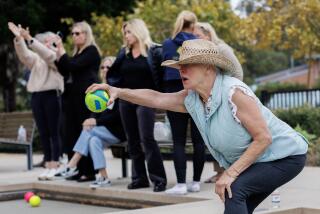THE FACTS ON . . . LAWN BOWLING : ABOUT THE GAME
- Share via
Lawn bowling should be as simple as rolling a black ball toward a smaller white ball on a smooth lawn, right?
Well, not quite. It looks simple until you try it.
Each shot in lawn bowling is played to set up the next, but the bowler must take into consideration opponents’ shots as well as teammates’ shots. As in golf, there are a variety of shots that can be played and the condition of the green can change the complexion of a game entirely. The game even has its own language and etiquette.
In lawn bowling, or bowls as the sport is called by players, the ball is weighted on one side so the ball curves. Depending upon which side of the bowl (the large black ball) is facing outward, the bowl will curve either to the left (a forehand) or the right (a backhand). The speed of the green also influences the bowl. Each green is different.
Taking all of that into consideration, players try to roll their bowls as close as possible to the white ball, or the jack. The side that has the bowl nearest the jack scores one point for that bowl plus an additional point for each bowl that is closer to the jack than the other side’s nearest bowl.
Strategy comes into play when players try to hit the jack into a position closer to their bowls or block the other team’s path. It can get difficult to weave a ball through a group of eight or 10 balls closely grouped around the jack. The skip or team captain stands behind the jack and gives standardized hand signals to direct the shots of his teammates. Games are usually played between two teams of three in the U.S., but singles, doubles and fours are also played.
Bowls are played in ends. After players on both sides have delivered their bowls in one direction, an end is completed and points are counted. The number of ends to be played is decided before the start of the game. The team with the most points at the completion of the determined number of ends wins.
Those are the basic rules, enough for one to get started. But, like golf, it is easy to learn enough to play. It takes a lot of practice and technique to become a good player. Tournament players practice eight hours a day, four or five days a week. The national governing body for men, the American Lawn Bowls Assn. (ALBA), publishes a 19-page booklet on strategy and technique and a 29-page rules booklet.
George Sincerbox, president of the San Diego Lawn Bowling Club, said beginning players throw a lot of “pineapples,” or balls that roll awkwardly rather than smoothly on their edges. But Sincerbox said it is only a short time before players can play well enough to play with the other members of a club on a typical afternoon.
WHERE TO PLAY
There are four clubs in San Diego County. The San Diego Lawn Bowling Club (237-9657), which has two greens, is located in Balboa Park near the Laurel Street bridge. The Escondido Lawn Bowling Club (745-6732), located on the private property of Dr. Edgar Haley, has a waiting list for membership. The Oaks North Bowls Club (487-0120), located in the Oaks North community in Rancho Bernardo, is open to Oaks North community residents only. The Rancho Bernardo Lawn Bowling Club (487-4058), located at 16789 Rancho Oaks Dr., is open to the public.
WHEN TO PLAY
The San Diego Club and Oaks North Club offer bowling every day except Monday. Bowlers can play on Monday, Wednesday and Saturday at the Escondido club. The Rancho Bernardo Club bowls every day except Sunday. White clothes are required at all times at Oaks North, but only on weekends and during tournaments at the other clubs.
HOW TO GET STARTED
All four clubs offer free introductory lessons and the use of bowls. The ALBA pamphlet, “You Can Be a Lawn Bowler,” states: “Excellent health is not essential and a lot of people play with physical handicaps.”
There are free lessons at the San Diego Club on Tuesdays and Fridays at 11 p.m. The club can also set up special times for working people. For more information, call the club office. Beginners must go through a four- to six-week training course at the Oaks North Club.
EQUIPMENT
A set of four bowls cost about $100. A carrying case costs between $20 and $70. Tournament players must wear all white, but that is not required in casual club bowling. A regular pair of white pants and any white shirt are sufficient. The only other requirement is flat shoes. Most players wear regular white tennis shoes. The clubs provide the mats and jacks.
More to Read
Go beyond the scoreboard
Get the latest on L.A.'s teams in the daily Sports Report newsletter.
You may occasionally receive promotional content from the Los Angeles Times.










